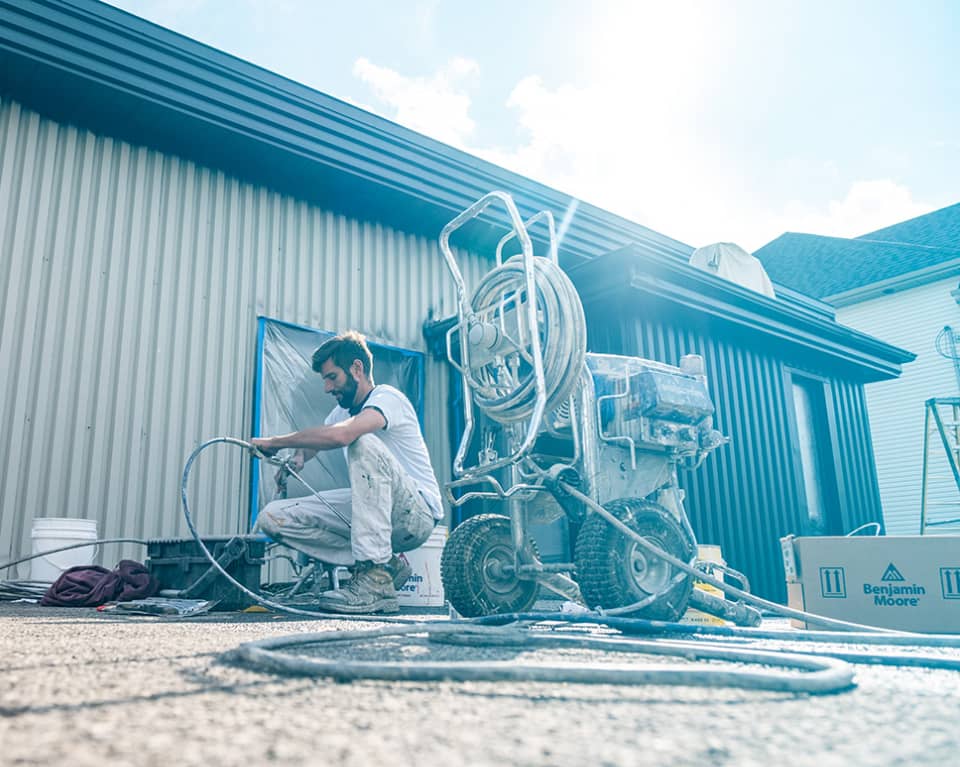How we proceed for metal painting
Before painting a metal, it’s important to identify properly the kind of metal and its condition in order to choose the appropriate products and painting techniques. In short, here is how our professional painters proceed for the different kinds of metal sidings: aluminum sheets, iron sheets, wrought iron, steel decks, and rusty metal.
Aluminum and iron sheets painting
Aluminium sheets sidings is what we often find on houses and buildings built in the 1970s and 1980s in certain Montreal neighborhoods. Those aluminum sidings gradually replaced the wooden sidings that were used previously to reduce the time spent on maintenance and to replace rotten wood. Now that the paint film of those sheets ages, it’s time to repaint to give it a great look, change the color and improve the architectural aspect of the whole building.
Aluminum and iron are the two types of metal coatings that we most often paint here at FinDecor. Large stores and warehouses façades are indeed a very common painter’s work.
Seen that aluminum is a non-ferrous metal, it won’t get corroded as iron would. Moreover, the paint sold today surpasses the dreamed adherence of 5 years ago and resists to UV rays and weather conditions. The longevity of the paint we use is absolutely phenomenal. Many persons still think that aluminum can’t be painted, since it was originally conceived to replace instable wood (wood contracts and stretches). No doubt, the blend of aluminum and paint in 2015 is so much better!
As for iron sidings, can become corroded. In this precise case, it implies a different approach than that of aluminum. First, we have to address the metal oxidation. Depending on the project and budget, several solutions may apply. The rust must be treated:
- mechanically (electrical grinder, manual or electrical sanding, scraping)
- chemically (rust annihilators, rust converters)
- with specially conceived coatings (rust retardant, rust inhibiting primer)
Depending on the scope of the problem and its severity of the corrosion, we can also eliminate future problems that could occurs by using a finish paint that prevents the appearance of more rust. For instance, we could use vapor paints and rust inhibitors.
If the rust is not visible and that the objective of the project is only a change of color, there are more options for the products we can use: DTM (direct to metal), urethanes, acrylic paint, latex paint, alkyd paint, epoxy compounds, etc. Depending on your needs, the weather conditions, and the surface, an array of products can apply. During your meeting with a FinDecor specialist, we will establish your needs, your priorities, and will discuss of the best solutions according to your budget.
The method we prefer for applying coatings on large surfaces is the spray painting gun. This clever technique gives a divine result. It’s however important to be careful: only an experienced painter can manipulate such tool as the weather conditions could otherwise compromise the success of the project.
Other sidings
Obviously, stucco, bricks, concrete, vinyl and PVC are not metals, but we can paint them using the same method as aluminum and their longevity is as surprising. Preparing and repainting those large exterior surfaces are everyday tasks for FinDecor.
Painting lintels and metal cornices
FinDecor also takes care of painting, replacing and repairing and metal cornices and lintels. See our page Painting at heights (cornice, lintels and others) to read more about it.
Dave Beaupre
Master-painter

